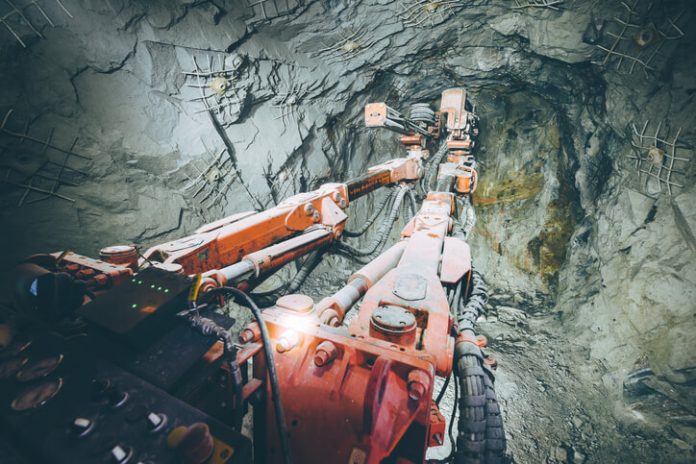Underground mining usually involves the digging of subversive tunnels and rooms below ground surface. Underground mining is more expensive than surface mining and can be dangerous. This kind of mining is only used in areas where quality ore, such as gold, are concentrated in thin veins and other remarkably rich deposits. Underground mines can also be excavated underwater, which is a significant advantage over surface mines.
Underground mining can be done when:
- The ore body is too thick to be mined profitably from an open pit.
- The quality and grades of the orebody are sufficient to cover costs.
- It has had a lower ground print than open-pit mining.
Over the centuries, the underground mining vocabulary has evolved. Shafts are vertical passages that are excavated below the Earth’s surface. On the other hand, Raises and winzes are vertical passages that are excavated upward or downward between horizontal works beneath. An adit, which is horizontally excavated into a hillside, is different from an incline, a sloped passage excavated inwardly from a hillside. Drifts are horizontal underground passages that follow the trend of an orebody. A stope is an open space beneath the surface. Its roof is called the back.
What Is Underground Mining?
Underground mining is the process of extracting materials from beneath the surface using various underground. As underground mining is a vast field of expertise and has different techniques employed, it is necessary to be aware of the potential dangers before embarking upon it.
The typical mining technique involves driving heavy machines underground, breaking up the rocks, and throwing them into a vat or tank below ground. However, with today’s modern equipment and techniques, the entire operation can be conducted above ground. Today, there are many techniques that have been developed that make this easier and safer.
With technology that allows for the safe transport and storage of all types of materials, including earth and rock, underground mines can continue to serve their essential purpose for generations to come. Suppose you or a loved one are considering working in an underground mine. In that case, it is essential to research the many benefits that exist and the possible consequences so that you can make an informed decision about whether or not it is right for you.
As long as there are minerals within the earth’s crust, there will be underground mining operations. Many different industries utilize underground mining, including gold panning, iron ore panning, limestone mining, slate mining, coal mining, petroleum exploration, and various others. This is a very stable business due to the fact that there is always the need for more of what was taken out of the ground, such as coal.
If you are planning on starting your own business or even working for an existing company, it will be crucial to understand how all of this works. If you already know how to do some of the work, then you will be fine. If you have no experience with any mining, it will be imperative that you learn everything you can about it before getting started. If you’re also considering investing in precious metals after understanding how mining works, you can read this Goldcore review to start.
Types of Equipment Used In Underground Mining
Large Mining Trucks
Heavy-duty trucks are required to move materials around the mine sites. They can be powered by both mechanical engines or have an environmentally friendly electric drive.
These mining vehicles are more significant than conventional trucks and have extra-large tires to support heavy loads on uneven terrain.
Large Dozers
Large mining dozers can move large quantities of materials around a mine site. You can also choose from wheels or tracks to increase the surface these dozers can operate on.
Hydraulic Mining Shovels
Mining shovels are sometimes called excavators. They evolved from the steam shovel design of years ago. Hydraulics are often used to move the shovel through hard materials.
Electric Rope Shovels
Electric rope shovels use a series of pulleys and ropes to move the shovel. These models, unlike hydraulic shovels, use electric operation, which allows for high efficiency and long-lasting performance.
Motor Graders
Access to roads is not always available for mines. Roads are still needed in the area to transport material and haul out mined goods. These roads are created and maintained by motor graders, which are used to perform surface operations near mines.
Draglines
Draglines are large excavators that have a bucket and wires attached to the boom. The bucket is lowered and scraped along the ground to collect overburden and mined material. The bucket can be repositioned by swinging it at the end of the dragline to deposit its contents in a designated location.
Wheel Tractor Scrapers
The wheel tractor scrapers are similar to motor graders. The scrapers are usually equipped with an attached bin to collect the material from the ground, rather than pushing it away like a grader.
Underground Mining Loaders and Trucks
Underground mining trucks and loaders need to operate in tight spaces. These vehicles can’t emit any emissions within a mine. Standard trucks for surface mining won’t work underground.






























![“Does Everyone Hear Me OK?”: How to Lead Virtual Teams Effectively iStock-1438575049 (1) [Converted]](https://www.europeanbusinessreview.com/wp-content/uploads/2024/11/iStock-1438575049-1-Converted-100x70.jpg)




